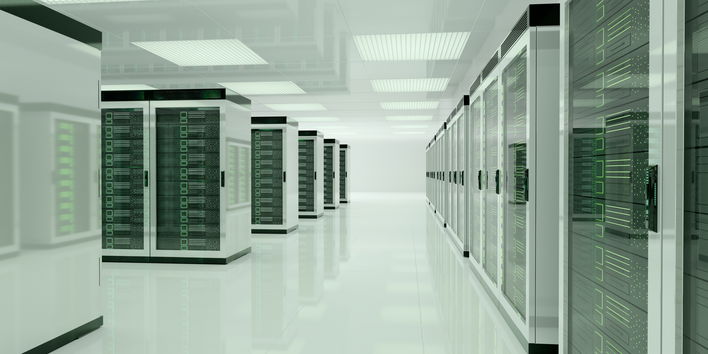You’ve invested in cloud platforms, rolled out digital initiatives, and upgraded legacy infrastructure. Yet despite these efforts, the results feel fragmented. Transformation feels more like a series of isolated upgrades than a unified leap forward.
For many enterprise leaders, the tension is growing: the pace of change is accelerating, but the returns on modernization remain elusive. What was meant to unlock agility and performance is often hindered by siloed execution, unclear KPIs, and organizational inertia.
That’s because enterprise modernization today is no longer just about technology. It’s about reengineering how your business operates structurally, culturally, and strategically to compete in a world that now moves in real-time.
In 2025, global supply chains are more volatile, customer expectations more fluid, and AI disruption more pervasive. Enterprises can no longer afford to treat modernization as a set of disconnected projects. It must be an integrated, enterprise-wide evolution.
Whether you’re modernizing store operations, factory systems, or distribution networks, the goal is the same: to build an intelligent, agile, and scalable business that delivers measurable outcomes, not just incremental upgrades.
According to McKinsey & Company, organizations that invest in true modernization improve performance and scalability, laying the groundwork for long-term resilience and growth. But to get there, you need more than new tools. You need a new lens.
This guide delivers it, breaking down what enterprise modernization means today, why it matters now more than ever, and how industry leaders are aligning strategy, technology, and operations to create an impact that lasts.
Redefining enterprise modernization in today’s business landscape
Think your systems are modern because you’ve moved to the cloud? That was step one. Today, enterprise modernization is less about catching up and more about staying ahead. It’s about building a business that can sense change, adapt in real time, and scale innovation without friction. In a landscape shaped by AI, digital ecosystems, and shifting customer behavior, modernization isn’t a destination; it’s how future-ready organizations now operate by default.
Defining enterprise modernization
In 2025, enterprise modernization is not simply a digital initiative; and it’s a business-critical evolution that redefines how organizations create value, compete, and adapt in a constantly shifting landscape.
Unlike past approaches that focused narrowly on replacing outdated systems or adopting individual technologies, modern enterprises recognize that transformation must extend across the full operating fabric, from infrastructure and data architecture to decision-making models and workforce design.
At its core, enterprise modernization means re-engineering your enterprise to be intelligent by design, where technology, process, and culture work in sync to deliver speed, flexibility, and insight at scale. It’s a shift from fragmented upgrades to strategic modernization, where every investment aligns with long-term business priorities rather than just addressing immediate operational gaps.
Modernization in this context is not a destination; it’s always a capability. It requires enterprises to evolve continuously, ensuring systems are not only scalable and secure but also deeply integrated with how the business thinks, operates, and grows.
Enterprises that succeed here don’t just modernize IT; they modernize how they operate and lead. This is the new definition of competitive advantage.
Enterprise modernization: Strategy over tools
Modernization goes beyond chasing new tools, it requires executing a clear strategy. With 60% of ERP projects failing and 49% of leaders struggling to realize cloud ROI, the challenge lies in the lack of strategic alignment. Tools support transformation; they don’t lead it.
True enterprise modernization connects business priorities, data, and customer experience with the right technologies.
When efforts happen in isolation, they deliver only fragmented gains. But when strategy sets the direction and tools follow, organizations achieve scalable, measurable impact, and shift from incremental upgrades to meaningful transformation.
The TPC framework: Technology, process, culture
To modernize effectively in 2025, enterprises must move beyond siloed upgrades and embrace a unified approach built on three core pillars: Technology, process, and culture, collectively known as the TPC framework. When treated separately, these pillars may yield incremental progress. But when integrated, they unlock transformation that is scalable, sustainable, and built for continuous reinvention.
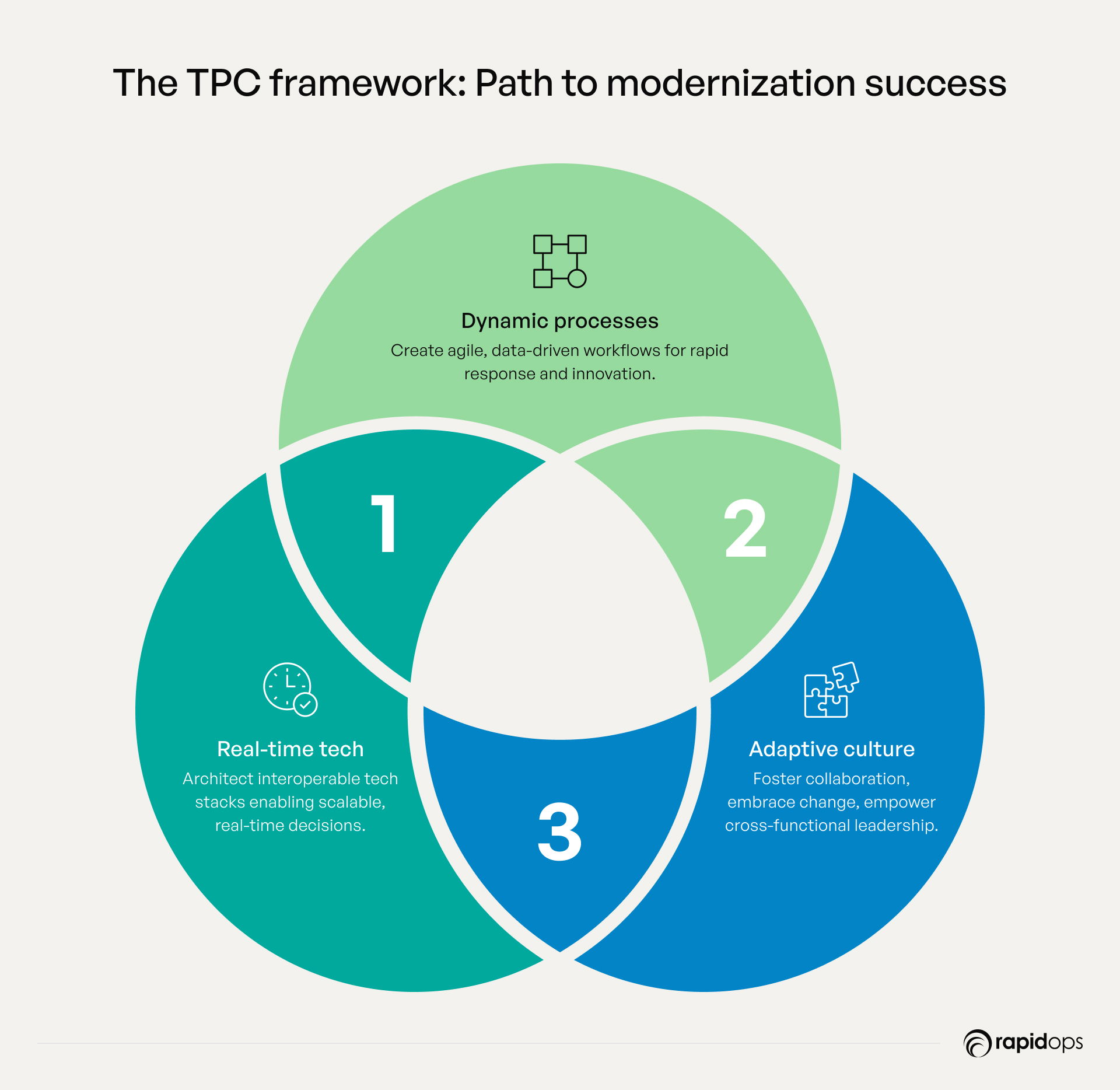
Technology: Cloud-native, real-time, and composable by design
Modernization today isn’t about adopting the newest tools; it’s about designing a cloud-native, composable, and real-time architecture that drives continuous agility. Forward-thinking enterprises are re-architecting their ecosystems with modular services, live data flows and embedded AI to create an infrastructure that’s responsive, not reactive.
To compete in 2025, your technology stack must support interoperability, scalability, and insight-driven decision-making. Systems must connect seamlessly, scale effortlessly, and adapt dynamically, empowering your teams to innovate faster and serve customers in real-time.
Process: From static workflows to agile, automated operations
Legacy workflows and rigid systems can no longer keep pace with today’s dynamic markets. The modernization mandate is to reimagine operations using workflow automation, agile delivery, and data-informed experimentation.
By embedding AI into core workflows, organizations shift from reactive, manual processes to proactive, self-optimizing systems. The result? Faster time to value, increased resilience, and a culture of continuous improvement that’s baked into daily operations, not just big change moments.
Culture: Driving digital dexterity and change adoption
Technology and processes are only as powerful as the culture that supports them. Without digital dexterity, the ability of your workforce to adapt, learn, and lead in digital environments, even the most advanced tools will underdeliver.
A truly modern enterprise invests in cross-functional collaboration, fosters a mindset of adaptive leadership, and promotes change adoption at every level. It’s this cultural muscle that turns transformation from a one-time project into an ongoing strategic capability.
Why the TPC framework works
The TPC framework eliminates fragmented modernization efforts by bridging systems, workflows, and people into a cohesive strategy. It ensures your transformation isn’t just digital on the surface but digitally mature at the core, resilient, intelligent, and prepared for whatever comes next.
Why enterprise modernization is now a business priority
Enterprise modernization has moved from the sidelines to center stage, not as a tech upgrade, but as a decisive business strategy. As industries face relentless disruption and accelerated innovation cycles, staying relevant means more than just “going digital.” It means rethinking how your business operates at its core. According to Gartner, by 2026, 75% of organizations will run on digital transformation models built on cloud as their foundation, not because it’s trendy, but because it’s the only way to stay adaptive, scalable, and competitive in a post-legacy world.
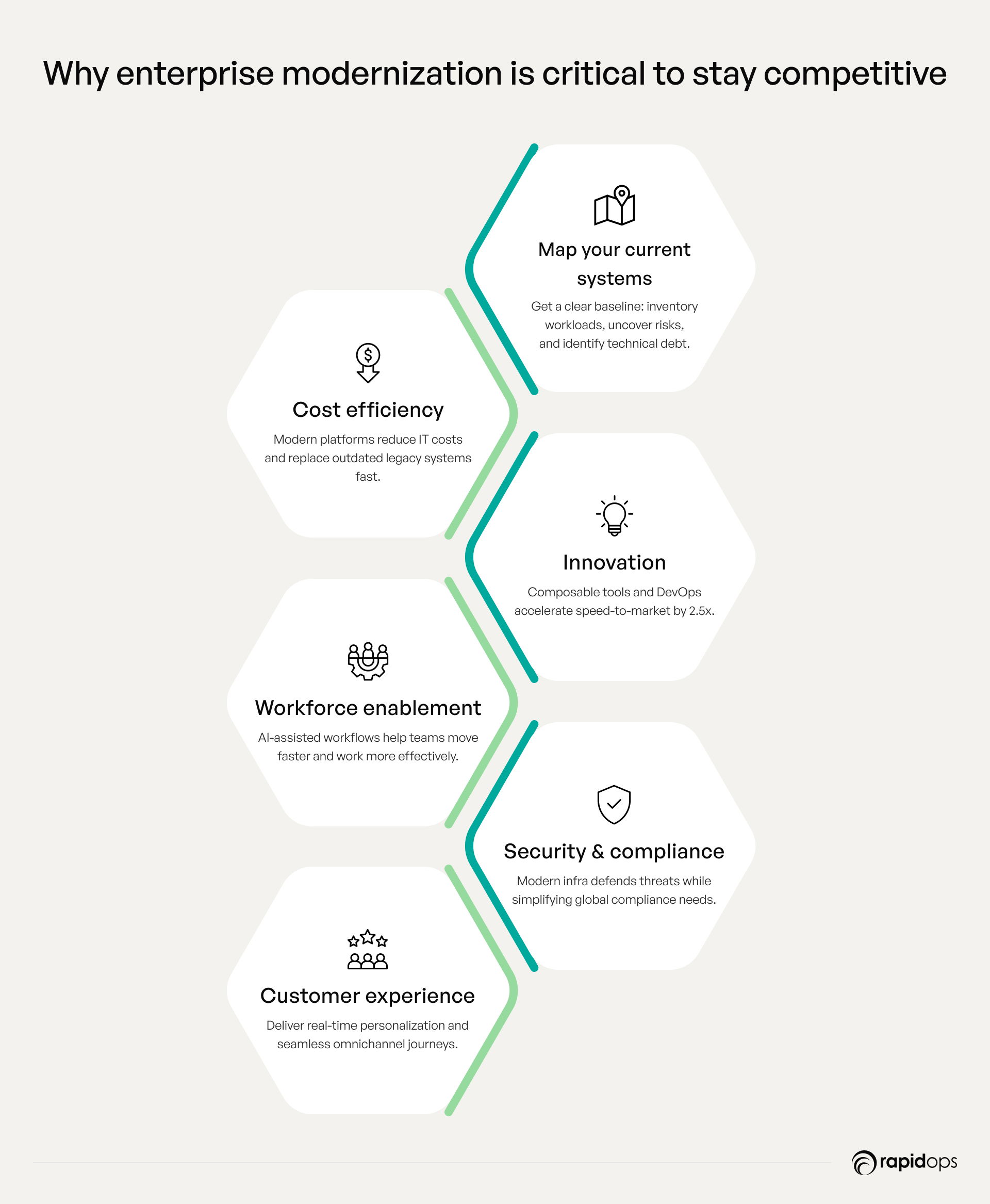
1. Customer-centricity and experience excellence
Customers choose brands that truly understand them, those that anticipate their needs and deliver personalized experiences in real-time. That expectation is now the baseline. 73% of consumers say customer experience directly influences their purchase decisions, and 49% are ready to buy on the spot when engagement feels personal.
Modernization gives your business the foundation to meet and exceed those expectations. With unified customer data, intelligent insights, and seamless omnichannel delivery, you can create meaningful interactions that build trust, deepen loyalty, and accelerate growth. Experience isn’t a touchpoint, it’s the relationship. And it’s how market leaders are being built today. To deliver these experiences consistently, businesses need the agility to evolve just as fast as customer expectations do.
2. Agility to adapt in a volatile market
Today's environment is unpredictable; supply chains, consumer behavior, and regulations shift with increasing speed. Modernization replaces rigidity with flexibility. By embracing modular architectures, API-first ecosystems, and real-time data orchestration, businesses can pivot operations and products faster, even mid-quarter.
Gartner reports that 75% of modernized enterprises were able to shift business models during major disruptions, compared to just 30% of their legacy-dependent peers. In sectors like retail, manufacturing, and distribution, this means faster route-to-market, real-time pricing, and adaptive supply chain execution.
3. Faster innovation and time-to-value
Innovation without speed is irrelevant and speed without structure is unsustainable.
Modern enterprises accelerate both through DevOps, platform engineering, and composable architectures that allow teams to build, test, and launch new digital offerings rapidly. According to Forrester, businesses with cloud-native and composable foundations bring products to market 2.5x faster than those relying on traditional systems.
This acceleration isn’t about chasing trends, it’s about delivering meaningful value to customers faster, adapting to market shifts, and staying ahead of competitors. To keep this pace, organizations need modernization at the core, ensuring that innovation not only happens quickly, but also scales reliably and delivers measurable outcomes.
4. Cost-efficiency and technical debt reduction
Enterprise modernization creates room for smarter capital allocation and long-term scalability. Outdated systems often lock up budgets and slow down innovation. By consolidating technology stacks, decommissioning redundant platforms, and shifting to flexible, usage-based models, businesses reduce operational costs while enhancing agility.
But success hinges on one critical factor: technical debt management. According to McKinsey, poor debt management can increase the risk of modernization failure by up to 40%. That’s why reducing technical debt is more than a clean-up, it’s a strategic move that empowers teams to build forward, not look backward.
5. Workforce enablement and digital dexterity
Your workforce can't thrive with yesterday's tools.
Modernization equips employees with AI-assisted platforms, streamlined workflows, and data-rich environments, enabling faster decisions, greater creativity, and more strategic thinking across roles. Deloitte reports up to 35% higher productivity among organizations that modernize their digital work environments.
But it's not just about performance; it's also about talent. As GenAI and automation become part of everyday workflows, people expect intuitive, empowering systems that elevate their potential.
And as employees become more digitally empowered, protecting the systems they rely on becomes non-negotiable, making modernization not only a catalyst for performance but also a pillar of trust and continuity.
6. Security, compliance, and resilience at scale
Cyber threats are more advanced, and regulatory demands are evolving rapidly. Legacy systems weren’t designed to manage this complexity, leaving organizations exposed and reactive.
Modern architectures embed security by design, using zero-trust frameworks, AI-powered threat detection, and automated compliance to proactively manage risk at scale. It’s not just about protection; it’s about long-term resilience.
According to IBM’s 2024 Cost of a Data Breach report, the global average breach cost has climbed to $4.88 million, the sharpest rise since the pandemic. Organizations leveraging AI and automation in their security operations reduced breach costs by $2.22 million, proving that modernization isn’t just strategic; it’s essential for financial and operational durability.
Enterprise modernization is no longer optional, it's the lever through which resilient, intelligent, and high-performing businesses are being built in 2025. Each of these strategic outcomes represents more than operational improvement; they’re the foundation for long-term differentiation and growth.
The strategic frameworks you need to know
Enterprise modernization isn’t a one-size-fits-all journey. It demands clarity of vision, disciplined execution, and structured decision-making. Without a strategic framework, even well-funded modernization efforts can devolve into fragmented initiatives that fail to deliver business value.
To move from intention to impact, organizations must anchor their modernization strategy around proven frameworks. These models help leaders make sense of complexity, prioritize initiatives, and accelerate outcomes across technology, operations, and culture.
Here are two high-impact frameworks that power successful enterprise modernization in 2025.
The 5Rs of modernization: A tactical lens for enterprise systems
Modernization is not a binary decision; it’s a spectrum of choices. The 5Rs framework provides a structured approach for modernizing legacy systems, prioritizing business value, technical feasibility, and long-term agility. Each “R” represents a different degree of transformation.
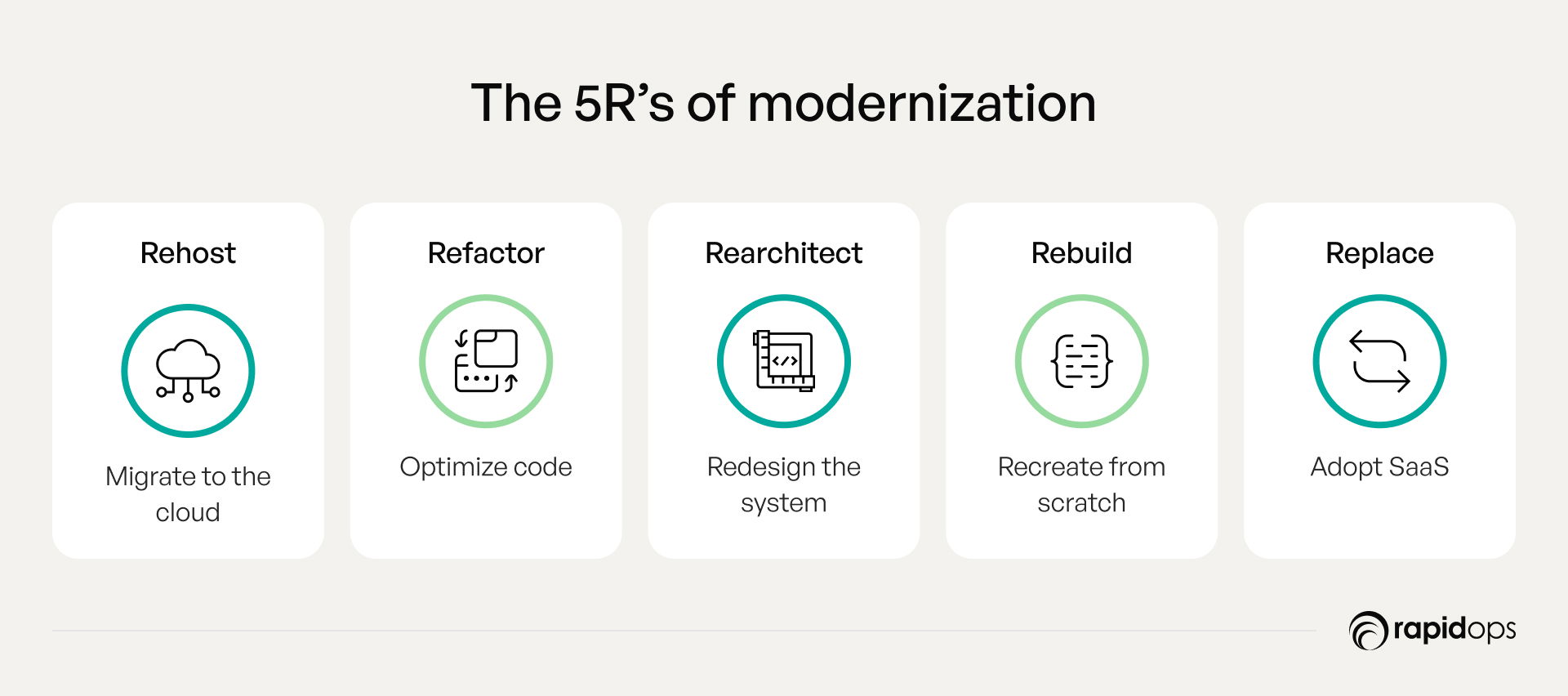
1. Rehost: Lift and shift with speed and control
Move applications from legacy infrastructure to the cloud with minimal or no code changes. This approach is often called “lift and shift.”
Strategic value:
Rehosting helps organizations exit aging data centers, reduce infrastructure costs, and increase scalability, without disrupting application logic or operations. It's the fastest way to gain early wins from cloud migration.
Use when:
- You need a quick migration with minimal disruption.
- Your systems are stable but costly to maintain.
- You want immediate infrastructure savings and scalability.
2. Refactor: Unlock agility without overhauls
Modify parts of an application to better leverage cloud-native features, while keeping the overall architecture intact.
Strategic value:
Refactoring strikes a balance between speed and value—it allows organizations to optimize specific components, improve performance, and reduce costs without rewriting everything. It’s ideal when full reengineering isn’t feasible, but improvements are needed.
Use when:
- You want targeted improvements (performance, cost, and scalability).
- The system is partially modern but not fully cloud optimized.
- You’re preparing for future rearchitecting.
3. Rearchitect: Redesign to support new business models
Redesign significant parts or the entirety of an application to adopt modern, cloud-native, or event-driven architectures.
Strategic value:
Rearchitecting enables enterprises to break free from monolithic bottlenecks, support new use cases (e.g., real-time data, AI, composability), and align technology with evolving business strategies.
Use when:
- Legacy architecture is slowing innovation or integration.
- Business processes are being redefined or scaled.
- You need systems to support real-time decisions, IoT, or AI.
4. Rebuild: Reinvent for the future
Recreate the application from scratch using modern development stacks, architectural best practices, and user-centric design.
Strategic value:
Rebuilding is a bold but essential move when legacy systems are beyond repair. It enables organizations to design for tomorrow embedding AI, mobile-first design, composability, and automation into the very core of the application.
Use when:
- The legacy system can no longer scale, secure, or innovate.
- You want to leapfrog competitors with new digital capabilities.
- Existing systems are built on outdated or unsupported tech.
5. Replace: Standardize with SaaS or COTS solutions
Retire the legacy system entirely and adopt a commercial off-the-shelf (COTS) or software-as-a-service (SaaS) product.
Strategic value:
Replacing systems allows enterprises to shift focus from maintenance to innovation. When a function is non-differentiating (e.g., HR, finance, CRM), SaaS solutions can offer faster deployment, built-in compliance, and continuous upgrades.
Use when:
- The system is not a competitive differentiator.
- SaaS or COTS options meet your needs faster and cheaper.
- You want to reduce TCO and improve scalability
The 5Rs aren’t just a framework, they're your guide to making smarter, faster, and more future-ready modernization decisions. Start where it matters, and move with clarity.
Modernization maturity model (2025): Moving from chaos to control
Modernization is not a one-time project, it’s a capability that requires ongoing investment. The modernization maturity model provides a phased approach to guide enterprises from fragmented efforts to a fully optimized, intelligent enterprise. Here’s how to map your journey.
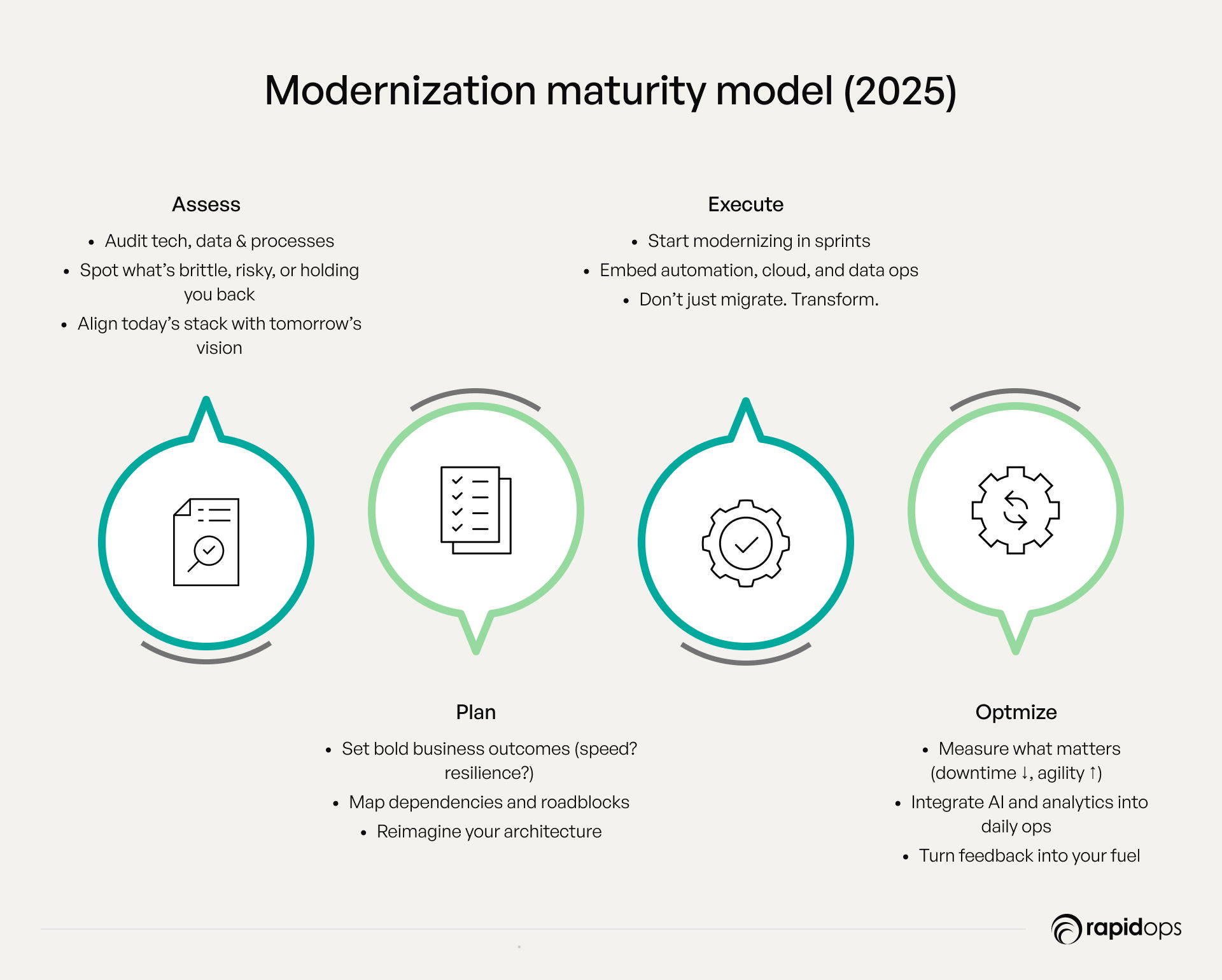
Phase 1: Assess
Where are we now?
In this stage, enterprises audit their IT landscape, data assets, business processes, and workforce readiness.
Questions to ask your IT team:
- What are our most brittle, costly, or non-scalable systems?
- Where are our security and compliance risks most concentrated?
- How aligned is our current stack with future business goals?
Phase 2: Plan
Where do we want to go, and how?
Leaders align modernization goals with strategic business outcomes (e.g., faster time-to-market, cost reduction, ESG compliance). This phase defines target architecture, prioritization, and investment roadmap.
Questions to ask:
- What does success look like speed, resilience, or innovation?
- What dependencies or change management challenges do you face?
- How will modernization impact our customer experience?
Phase 3: Execute
Build the future with intention not just fix the past.
This is where change happens. Enterprises begin system migrations, infrastructure upgrades, automation initiatives, and culture shifts in parallel.
Focus areas:
- Incremental releases with business feedback loops
- Data governance and AI/ML readiness
- Change management and training enablement
Phase 4: Optimize
Modernization doesn’t stop, it evolves.
In this final phase, organizations embed continuous improvement into operations. It’s about tuning systems, processes, and culture to sustain innovation.
Focus areas:
- KPIs linked to business value (e.g., reduced downtime, improved NPS)
- Continuous integration of AI and analytics into core workflows
- Cross-functional agility and learning loops
Bringing it all together
These frameworks aren’t theoretical, they’re operational blueprints. By leveraging the 5Rs and the modernization maturity model, enterprise leaders can cut through complexity, prioritize action, and modernize with confidence. The result? A more responsive, resilient, and value-driven organization, one that’s not only ready for the future but actively shaping it.
How enterprise modernization is executed
What does it actually take to modernize an enterprise in 2025? Not just big ideas, but the ability to execute with speed, clarity, and consistency. From aligning teams to modernizing core systems, execution is where strategies are tested and outcomes are realized. This section outlines a practical, proven roadmap that today’s forward-looking enterprises are using to move from intent to impact, so you can lead transformation that scales, delivers value, and lasts.
1. Assessment: Visibility first
Every successful modernization starts with knowing where you stand. This phase helps uncover technical debt, performance bottlenecks, security vulnerabilities, and cost inefficiencies.
Tools & methods:
- CMDB (Configuration Management Database): Provides a system-wide map of dependencies and components.
- Application portfolio rationalization: Identifies redundant, obsolete, or underutilized apps.
- Performance monitoring tools (New Relic, Dynatrace): Real-time performance benchmarks and service metrics.
- Security risk scans: Assess outdated protocols and compliance gaps.
Creates a shared understanding across IT and business, ensuring modernization aligns with ROI priorities and risk thresholds.
2. Strategic planning: Align with business outcomes
This is where modernization becomes more than just tech; it’s embedded into business growth, customer experience, and operational efficiency.
Tools & methods:
- Value stream mapping: Identifies where modernization will unlock business value.
- TCO/ROI analysis: Justifies investments with forecasted returns and efficiency gains.
- Reference architectures & governance models: Set guardrails for scalability and interoperability.
Helps executives prioritize initiatives that move the needle, not just what’s trending. Clear visibility into cost-benefit trade-offs builds stakeholder confidence.
3. Agile execution: Build with speed and discipline
Modernization execution today is powered by DevOps, platform engineering, and Agile delivery. The focus here shifts from planning to building fast, iteratively, and without breaking existing systems.
Tools & methods:
- CI/CD pipelines (Jenkins, GitLab): Automate testing, deployment, and rollback.
- GitOps & infrastructure as code (IaC): Ensure environment consistency and version control.
- Platform engineering: Create reusable platforms to support product teams at scale.
- Service reliability engineering (SRE): Ensure system performance under real-world load.
Reduces time-to-market and supports faster experimentation, especially valuable in dynamic industries like retail, logistics, and fintech.
4. Cloud & platform modernization: Build future-ready infrastructure
To scale modernization, enterprises are re-architecting on cloud-native platforms using containers, microservices, and multi-cloud strategies.
Tools & methods:
- Containers (Docker), Orchestration (Kubernetes): Isolate services for speed and resilience.
- Serverless architectures: Reduce infrastructure overhead and scale functions independently.
- IaC with Terraform or Pulumi: Enables repeatable, compliant infrastructure across environments.
- Cloud FinOps: Optimize cloud usage and control spend proactively.
Reduces infrastructure cost, eliminates vendor lock-in, and unlocks digital scalability on-demand.
5. Monitoring & continuous optimization: Iterate to excellence
Modernization is never “done.” Continuous feedback, observability, and iteration turn systems into living platforms that evolve with your business.
Tools & methods:
- AIOps (Moogsoft, Datadog): Predict and prevent failures through ML-based insights.
- A/B testing & feature flags: Safely release and experiment with new features.
- Observability platforms (Grafana, ELK, OpenTelemetry): End-to-end visibility across services.
- KPIs dashboards & business metrics: Align technical performance with business goals.
Ensures modernization efforts don’t degrade over time and can evolve based on customer, operational, and market needs.
“High-performing organizations treat modernization like a growth flywheel - every release strengthens the next,” McKinsey.
This execution roadmap isn’t just a checklist; it’s a modernization operating system. When tied to clear outcomes, empowered teams, and adaptive platforms, it becomes the foundation of a business that can thrive amid constant change.
How are mid-sized enterprises modernizing without starting over
Modernization today means making what you’ve built work harder, not replacing it. Mid-sized enterprises are rethinking how to extend the value of existing systems, proving that transformation isn’t about starting from scratch, but evolving with purpose, precision, and practicality.
Betabrand: From crashing carts to cloud-native confidence
When Betabrand, a rising mid-sized fashion retailer, started losing customers during traffic spikes, it wasn’t just a tech problem. It was a growth ceiling.
With a legacy eCommerce system that couldn’t scale, every seasonal peak felt like a risk. Website crashes, long load times, and deployment delays were hurting both the brand and the bottom line.
So, what did they do? They didn’t rebuild everything; they modernized the foundation.

Their move to a cloud-native setup gave them control over scale, speed, and innovation without the operational chaos that often accompanies traditional setups.
The takeaway: Modernization in retail doesn’t start with ambition; it starts with pressure. Smart modernization turns that pressure into performance.
Unipart Group: Automating around the Edges, winning at the core
Unipart, a respected name in automotive components, wasn’t dealing with outdated machinery; they were buried under obsolete processes. Procurement and invoicing workflows were bogged down with manual tasks, resulting in avoidable delays, errors, and frustrated vendors.
But like many mid-sized manufacturers, they couldn’t justify a full ERP replacement.
The answer? Wrap intelligent automation around what already works.
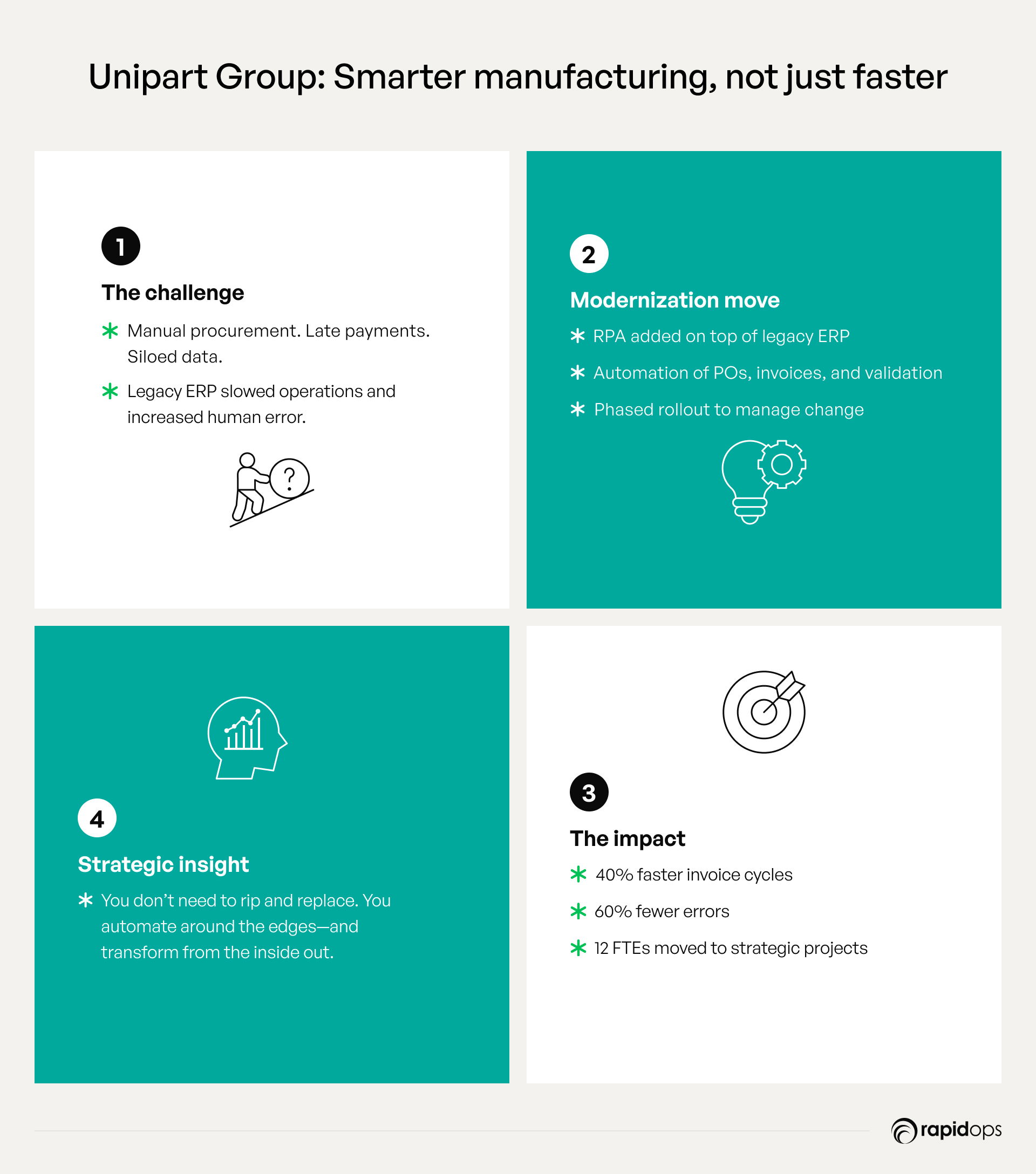
With RPA, they turned repetitive tasks into no-touch processes, preserving their legacy ERP while unlocking next-gen efficiency.
The insight: You don’t need to start over to move forward. You need to make legacy systems smarter, one step at a time.
Crescent Crown: From fragmented systems to fluid supply chains
As a regional beverage distributor, Crescent Crown faced a classic distribution challenge: having too many systems and insufficient visibility into its operations. Order fulfillment lagged, inventory accuracy dipped, and their teams lacked the data to respond in real-time.
They didn’t wait for the perfect system. Instead, they rebuilt their logistics backbone with modular microservices and connected every moving part using a unified data fabric. This shift didn’t just expedite logistics; it transformed how the business thought and operated.

The lesson: For distributors, modernization isn’t about flashy tech; it’s about real-time visibility and market responsiveness.
Modernization that meets you where you are
You’ve now explored what enterprise modernization truly means in 2025, not as a buzzword but as a strategic, real-world shift. You’ve seen how leading organizations are evolving what already exists, applying flexible frameworks, and unlocking value without having to start from scratch. More importantly, you’ve likely seen reflections of your own journey, questions you’re asking, pressures you’re navigating, and ambitions you’re shaping.
Maybe your technology still works but doesn’t scale. Maybe your teams are stretched across fragmented tools. Or perhaps you’re being asked to move faster and be more agile without risking what’s already in place. Wherever you are, between legacy realities and future growth, you’re not alone. And you don’t need to have it all figured out before moving forward.
At Rapidops, we’ve spent 16 years helping enterprises like yours modernize with clarity and confidence. We’ve worked with teams across industries from retail, manufacturing and logistics, guiding transformation not with generic frameworks but with tailored, execution-ready strategies rooted in your reality. Whether it’s re-architecting systems, introducing microservices, or enabling real-time intelligence, we help you move with purpose and without unnecessary disruption.
If this article sparked new thinking or offered a moment to reflect you’re already on the right path.
Schedule a conversation with one of our enterprise modernization experts. We’ll focus on where you are, where you want to go, and how to build a roadmap that works for your enterprise, your teams, and the future you’re shaping.
What is the difference between enterprise modernization and digital transformation?
While both enterprise modernization and digital transformation involve upgrading technology, they have distinct focuses. Enterprise modernization is primarily about updating and optimizing legacy systems to improve performance, scalability, and integration. This may include moving systems to the cloud, adopting microservices, and upgrading infrastructure. Digital transformation, on the other hand, is a broader concept that encompasses an organization-wide shift to digital-first operations, rethinking how technology can fundamentally change how a business operates and delivers value. Digital transformation often includes enterprise modernization as a component, but it also focuses on areas like digital culture, customer experience, and new digital business models.
How can small and medium-sized businesses benefit from enterprise modernization?
SMBs stand to gain significant benefits from enterprise modernization, even with more limited resources. For small and medium businesses, modernization can reduce operational costs, streamline workflows, and enhance customer interactions by implementing efficient and scalable technology solutions. Cloud-based systems, for instance, allow SMBs to avoid large hardware investments while gaining flexibility to scale up as they grow. Furthermore, by adopting automation and modern applications, SMBs can improve employee productivity, reduce downtime, and respond to customer needs faster—advantages that are essential for competing with larger companies in today’s market.
What are common challenges companies face during modernization?
Enterprise modernization, while beneficial, does come with challenges. One of the primary challenges is the upfront investment, as modernization often requires significant initial funding. Another challenge is the risk of disruption, especially if critical systems are being migrated or restructured, which can lead to downtime or reduced productivity in the short term. Data migration complexities, especially when transferring large amounts of information to new systems, can also pose risks if not managed carefully. Additionally, employees may resist the change, particularly if they are used to familiar processes and tools, making it essential to have effective change management strategies in place.
Is enterprise modernization worth the investment for companies with limited budgets?
Absolutely. Enterprise modernization can be especially valuable for companies with limited budgets, as the long-term benefits often outweigh the initial costs. Although modernization requires upfront expenses, the cost savings achieved through improved efficiency, reduced maintenance, and fewer hardware requirements can provide substantial returns over time. Cloud-based solutions, for example, offer companies a way to modernize their infrastructure without needing costly on-premises equipment. Additionally, many modernized systems support automation, which can reduce labor costs and improve productivity, helping businesses with tighter budgets maximize their resources.
How long does a typical enterprise modernization project take?
The duration of an enterprise modernization project varies depending on the size of the company, the complexity of its systems, and the scope of the modernization effort. Small-scale projects may be completed in a few months, while larger, more comprehensive overhauls could take several years. A phased approach is often recommended, where specific components are modernized one at a time to minimize disruption. For example, a company might start with cloud migration, then focus on updating its applications, and finally address process improvements. By breaking the project into phases, companies can continue operations while progressively modernizing.
What role does cloud migration play in enterprise modernization?
Cloud migration is a cornerstone of many enterprise modernization efforts. By moving to the cloud, companies gain access to scalable and flexible infrastructure, allowing them to quickly adjust their resources based on demand. This flexibility is particularly beneficial for businesses experiencing growth or fluctuations in customer demand. Additionally, cloud providers often offer advanced services, such as data analytics and machine learning, that can enhance business intelligence and decision-making capabilities. Beyond flexibility, cloud migration typically results in lower hardware maintenance costs, as the responsibility for physical infrastructure shifts to the cloud provider, allowing businesses to focus on core operations.
How does enterprise modernization impact cybersecurity?
One of the key advantages of modernization is the ability to adopt advanced cybersecurity measures. Legacy systems can be vulnerable to security risks because they may no longer receive updates or support, making them susceptible to cyber threats. Modernized systems, however, are built with the latest security protocols, including real-time threat monitoring, encryption, and identity management features. These enhancements significantly reduce the risk of data breaches and ensure that companies can comply with industry regulations. As a result, enterprise modernization not only improves operational efficiency but also strengthens a company’s security posture and protects its reputation.
How can companies ensure a successful enterprise modernization initiative?
Ensuring the success of an enterprise modernization initiative involves a strategic, multi-faceted approach. First, it’s crucial to have a clear vision and well-defined goals, ensuring that the modernization aligns with overall business objectives. Careful planning, with a roadmap that addresses each stage of modernization, is essential for managing timelines and budgets. Additionally, involving stakeholders from different departments and fostering a culture that embraces change can facilitate smoother transitions. Continuous monitoring and optimization are also vital, as these practices allow companies to adjust their strategies based on real-time data and feedback. By adopting a phased approach, using best practices in change management, and leveraging the expertise of experienced partners, businesses can significantly improve their chances of a successful modernization.

Saptarshi Das
Content Editor
9+ years of expertise in content marketing, SEO, and SERP research. Creates informative, engaging content to achieve marketing goals. Empathetic approach and deep understanding of target audience needs. Expert in SEO optimization for maximum visibility. Your ideal content marketing strategist.
What’s Inside
- Redefining enterprise modernization in today’s business landscape
- Why enterprise modernization is now a business priority
- The strategic frameworks you need to know
- How enterprise modernization is executed
- How are mid-sized enterprises modernizing without starting over
- Modernization that meets you where you are

Let’s build the next big thing!
Share your ideas and vision with us to explore your digital opportunities
Similar Stories
- Strategy
- undefined Mins
- February 2017

- Transformation
- undefined Mins
- March 2022


Receive articles like this in your mailbox
Sign up to get weekly insights & inspiration in your inbox.
